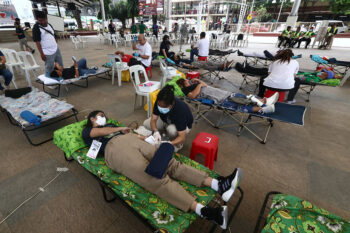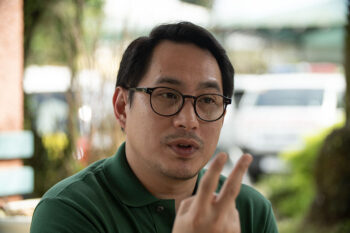The development of the Moro Islamic Liberation Front (MILF) has been wrapped in such a colorful history. To some extent, the MILF itself, as an organization, continues to be viewed in some mystery of what it is and what it is not. In Datu Michael O. Mastura’s book, he unravels some of this mystery for those interested to understand the ideologies that catapulted the MILF as one of the most successful revolutionary movements of its time. The Foreword in Datu Michael O. Mastura, Bangsamoro Quest: The Birth of the Moro Islamic Liberation Front (Penang: SEACSN & REPUSM, 2012) is published in this column. It is hoped that this Foreword shall inspire the Bangsamoro and Filipino youths to read histories that continue to shape our futures.
FOREWORD
This is a very important book, written by a very important figure in the long history of the Bangsamoro struggle. It asks many questions and reveals many things about this struggle from the perspective of one who has been involved as an insider, and is still very much in there as an original and current member of the MILF peace panel in the peace talks with the GPH.
The book discusses the core questions behind the struggle of a liberation movement in an identity-based self-determination type conflict. Why it got started; what is the philosophy behind the struggle; who have been involved; what is the current situation; and where is it heading. These are some of the core questions that Datu Michael Mastura focuses on in this book.
The book is titled Bangsamoro Quest: The Birth of the Moro Islamic Liberation Front (MILF). The title is perfect because it reflects a journey or a struggle of a people in search of a destination. It also focuses on the MILF as the vehicle that drives this struggle for the people. If liberation is both the end and the process, then the MILF is the movement that moves this process.
Liberation Movement
How does a liberation movement generally come about then? Looking at similar situations, the standard answer would involve a number of inter-related factors, which usually starts with the fact that the “affected people” are not happy with the way they are being treated as a group by the state. There are a number of causes to these grievances that cut across politics, economy, territory, identity, and religious lines. Delving deeper one can probably find that these affected people once belong to a proud nation with a history of self-rule, by their own rulers with normal functioning institutions and practices; that they were then invaded, coerced, or tricked into submission and colonization. As the story goes, there are perceived injustices perpetrated on the affected population, including the takeover of their land through dubious means and oppressive actions by the state or the majority in this asymmetrical relation, in suppressing any demands for change and justice. Lastly, there exist mass supports amongst the affected population for the movement. In some cases there is also support for the movement from kin groups abroad, usually in neighboring countries.
Ted Gurr, writing his seminal book in 1970 about Why Men Rebel said that “…mass revolutionary and secessionist movements are likely to develop if discontent is widespread and intense among both elite and mass, the result of relative or absolute deteriorations of many conditions of social existence.” (Gurr, 1970: 343).
Two important things to note here is widespread discontent being felt by all and the deteriorations of social existence. The Bangsamoro struggle as explained by Mastura is one that came out of this feeling of widespread discontent. The discontent has to do with the fact that the Bangsamoro people felt that their once proud nation had been overrun by a series of invaders which included the Spanish, the Americans, and lastly the Filipinos. These waves of invasions and dominations have contributed to the deterioration of their social existence, and as a consequence, they have lost control of their right to determine for themselves the direction of their own destiny.
As mentioned by Mastura in this book, the late Chair Salamat Hashim, in a letter to President Bush put forward “a realist argument that MILF is a national liberation organization with leadership supported by the people and with legitimate political goal to pursue the right of the Moro nation to its political status.” (Mastura, 2011: 88) This “political status” is something that the current GPH-MILF peace process is trying to figure out.
The MILF is involved in a revolutionary war. Mastura quoted current MILF Chair Ebrahim Al Haj Murad who says that “a revolutionary war is the ability to sustain a protracted struggle,” explaining that “self-reliance means every group to each its own to care for; each one is mujahid.” (Mastura, 2011: 80) To Mastura, this is the “galvanizing ideology” for the “people’s war” in Mindanao. The MILF has been able to survive and flourish because of the commitment of the people under this mujahid mentality, which also provides them with legitimization for the struggle. This legitimization is an important source of power and legitimacy for the MILF. Mastura also discusses at length about Islam as a source of motivation for the struggle of the MILF. But rather than it being part of a regional or global pan-Islamic movement, it is really a home-grown struggle driven by what Hashim called a “national liberation organization” to correct past injustices to the Bangsamoro people.
The MILF has no qualm about turning this revolutionary war into an armed conflict. That they have acted violently as a reaction against their perceived enemies and invaders is deemed normal under this revolutionary war circumstance. Adam Curle noted that this is part of the process of pushing for change – of transforming a perceived unbalanced situation. It involves a process of “conscientization” and of “confrontation” before a balanced peaceful situation can be achieved (Curle, 1971).
Understandably, depending on the context, change can be a source of conflict or it can be a means of resolving conflict. In situations where a dominant group or elite is entrenched in power, any efforts to bring about a change can be seen as threat to their position and authority. However, it is also possible that any change which addresses the causes of conflict, and which is agreed and implemented through a consultative and inclusive process, could help to reduce levels of conflict and violence.
Expectations and Relative Deprivation
The level of violence perpetrated during this “confrontation” period can be determined from the extent of popular support for the cause, both internal and external, and what Gurr called the “intensity and scope of relative deprivation among members of a collectivity” (Gurr, 1970: 24). Gurr defines “relative deprivation” as “actors’ perception of discrepancy between their value expectations and their value capabilities. Value expectations are the goods and conditions they think they are capable of getting and keeping,” with values being the desired events, objects, and conditions for which the group is striving for.
Simply put, value expectations are conditions that they feel they are justifiably entitled to; or conditions that they have lost and now wanting back; or territories that they have lost and now wanting back; or power that they have lost and also now wanting back. And all the while and for everything, the expectation is that they are justifiably entitled to all these, since these were forcibly taken from them. Their action then is to address these past injustices, and to be compensated for that. Value expectations also refer to both present and future conditions, as they expect to keep not only what they have, but also have a set of expectations and demands about what they should have in the future, which is usually as much or more than what they have at present.
Relative deprivation is also connected to value capabilities, or the value position members of the group perceive themselves capable of attaining or maintaining. “Value capabilities also have both present and future connotations. In the present, value capabilities are represented by what men have actually been able to attain or have been provided by their environment: their value position. In the future, value capabilities are what men believe their skills, their fellows, and their rulers will, in the course of time, permit them to keep or attain: their value potential.” (Gurr, 1970: 25)
Understanding these relative deprivation and the connections that it has to values deemed important to the aggrieved group is crucial in addressing their concerns. Gurr concluded that, “…if men fight to preserve what they have, concessions that remove the threat to it are sufficient. If they rebel to satisfy new or intensified expectations, the only effective concession is to provide them with means adequate to these expectations.” (Gurr, 1970: 359) (italics added)
Expectations and Peace
What does this mean then for those attempting to transform and resolve this type of conflict? A good starting point is to answer the following questions usually put forward to address issues of self determination – how to satisfy demands for, and resistance to, autonomy, self determination and separation; and how to accommodate the needs of the minorities, and the insecurities of the majorities, in deeply divided societies. Basically asking first what is it that the actors want and if that is really what they and the people they represent want; second, what effect does this demand has on others sharing the same space; and third, finding a formula that will satisfy this demand while at the same time making sure the needs and interests of others affected by this decision is not jeopardized.
The previous discussion talked about expectations and means to satisfy these expectations. Can it be assumed that the expectation for the Bangsamoro people is for self-determination and that the comprehensive compact that is currently being debated by the parties can create a new political arrangement for the Bangsamoro people to achieve this expectation? Or that the expectation is to reduce relative deprivations being faced by the Bangsamoro people through years of neglect and mismanagement by allowing their present and future value capabilities to fulfill or reach their value potentials? Reading from Mastura in this book, the answer would be a resounding yes to both questions.
The former Prime Minister of the Gerakan Aceh Merdeka (GAM or Free Aceh Movement) once told this author, after they signed a peace agreement with the Indonesian government, that all GAM ever wanted from their struggle was “peace, justice, and dignity” for the Acehnese people. They started their armed struggle against the Indonesian government because of this and they ended this struggle because they feel that they can get want and need through negotiation. GAM signed a peace agreement with the Indonesian government in August 2005 that ended the conflict. They eventually gave up their weapons, disbanded the GAM, and transformed themselves into a political party in Aceh. All because they now feel that “peace, justice, and dignity” is within their reach (some of them would even say, have been achieved). Another almost similar case is Southern Thailand, where there has been a long-running self-determination struggle involving the Malay-Muslims or Patanis demanding independence from the Thai state. There is no “legitimate” peace process of any kind in this conflict as yet. In regards to “peace”, a senior member of the Patani United Liberation Organization (PULO) told the author recently that what they want is “resolution of the conflict, not peace”. This is interesting as to them peace does not necessarily equate to the resolution of the conflict. This is probably due to the fact that past peace initiatives made by the Thai state have not addressed the issues as seen by them, nor have they felt that their grievances have been properly addressed through these one-sided peace initiatives.
The point from these two cases is that each liberation movements make their own goals and chart their own courses, to reach their own destinies. The same can be said about the MILF, whom I believe is committed to the notion of “peace, justice, and dignity” and to resolving the Bangsamoro issue.
Mastura also made a point in this book that the “MILF in its comprehensive compact draft aspires for separate national identity, as Bangsamoro, while retaining their Filipino citizenship. Closer to homeland, state is a justificatory concept (political) hence contested in meaning on the question of Bangsamoro identity and status. “(Mastura, 2011: 134). This then is the expectation of the MILF with the sub-state formula being proposed as the means that can help achieve this expectation and resolve the conflict.
Peace Process
This book also gives some insights about the peace process, including the current talks being facilitated by Malaysia. In general a peace process can be seen as “persistent peace initiatives that develop beyond initial statements of intent and involve the main antagonists in a protracted conflict” (Darby and Mac Ginty, 2008: 3)
The process itself involves an extensive set of variables: for example the peace initiatives can be formal and informal, public or private, subject to popular endorsement or restricted to elite-level agreement, and can be sponsored by external sources or spring from internal sources. It is also a fact that all peace processes are fragile, and most fail sooner rather than later. Lastly, the implementation of a peace accord is dependent on the political will of the parties and on international and economic context.
Achieving peace in a protracted armed conflict like the one in Mindanao is difficult. At the end of the day, it is accepted that a military strategy has its limitations. The attainment of “expectations” and “means” to fulfill these expectations must be tied to another process which focuses on dialogue. Success of this process depends on a number of factors which may include the following:
1. Sincerity and willingness of the armed actors to engage peacefully. This is not only the beginning but also the most crucial point. Without sincerity there can never be a solution. Efforts for peace will just be for show – to win votes, get funding, support, or position. It is heartening to note though that in this current talks both sides have shown sincerity and political will.
2. Possibility of starting a peace process. This refers to the need to set the scene for a process to begin. Are the parties ready? Are they clear with their expectations; not only with the end result but also with the process? Do they have the people with the skills and knowledge to negotiate with the other side? Do they have the mandate of the people and the masses that make up or contribute to the “movement”?
3. Inclusivity. It should involve all the necessary actors including the “militant” groups; if possible, including the different factions as well. This is because neglected parties might go on to become potential spoilers in the process. Inclusivity also means involving the affected public and other stakeholders through a process of consultation. The public need to know what is going on and what is the current status of the process. Uninformed public can lead to dissatisfaction with the process and unwillingness to support any decision made as well as future implementation exercise. Both sides have been actively engaged in this activity, especially since the collapse of the MOA-AD talks in 2008 and the subsequent Supreme Court rulings.
4. Anticipating and managing the problem of continuing violence. There are bound to be incidences of violence perpetrated by over-anxious elements in a long running armed conflict like this. The MILF has had to deal with dissatisfied and impatient local commanders wanting to move faster and venting their frustration in a violent manner, while the GPH has been having problems of coordination of activities on the ground, resulting in confusion in strategies and misadventures which have proved disastrous for them. Where possible, the issue of continuing violence has to be managed in a proper way.
5. The Mindanao process comes with an early agreement on a ceasefire and the creation of bodies to monitor and take action of situations on the ground, such as the Coordinating Committee on Cessation of Hostilities (CCCH), the Ad Hoc Joint Action Group (AHJAG), and the Malaysian-led International Monitoring Team (IMT). At the same time, it should be noted that the absence of war or armed confrontation is not peace. Just because the sides are not currently in direct armed confrontation with each other does not mean that they are satisfied with the process or that they will not be involved in a confrontation in the future. It just might mean that the mechanism to anticipate and manage violence is working well. This would have to be supported by other mechanisms in the process.
6. Being organic and cumulative. This basically means that efforts for peace must come from within, from the soil of conflict and the nation. It cannot be imposed from outside or decided and dictated by those who might not be in touch with local realities. The process is dynamic in nature and each exercise builds on the previous ones. What has been decided should be honored and not “un-decided” or reversed. Commitment to build a joint future should be based upon achieving justice for the past. International “best practice” can be a guide but should not overwhelm the process as achievements based on local traditions which understand localized needs can at times prove to be more enduring.
7. Willingness to bargain or deal creatively with each other. Peace processes are deals, they require trade-offs. Each comes with their own interests and positions, but it should not be a scenario “of take it or leave it”. Moving from a personal interest or position to a joint one requires a whole lot of ingenuity. Negotiation is not a race and there is no prize for those finishing first. The prize is when they are able to come up with a formula for a sustainable and enduring peace that can fulfill the expectations of both sides.
8. The ability of the leaders to deliver their own people – persuading their followers to endorse the process and the decisions. The leaders are effective as long as they are provided with the support and mandate of their respective constituents. Peace negotiations are done not only for the people but should take the people’s interests, needs, and aspirations into account. Insofar as this is done, the people will lend their support to the process, including endorsing and implementing any decisions made. Political elites then must find ways to broaden the appeal of the peace process and peace accords.
9. In some processes, an important point is being able to re-integrate members of the security forces and paramilitary groups into normal society. Such initiatives must be integrated with moves to address the needs of the victims of violence. This is important especially when you have a large standing security force. Those not re-integrated properly might become potential lost-command spoilers. Although the situation of Mindanao is not exactly the same as the one in Aceh, there are lessons that can be learnt from the re-integration process of former GAM combatants.
10. Peace is a development issue. Sustaining peace depends in large part on the ability of the leaders to deliver peace dividends to the long suffering masses. People expect the relative deprivations that they suffered during conflict times and that have brought about the revolutionary war in the first place to be resolved. Development is also a strategy to ensure economic grievances are addressed. Failure to address development and livelihood issues may lead to a public disenchantment that overshadows political or constitutional compromises.
11. A peace accord does not end the peace process. An agreement on democratic access to, and distribution of, power has to be agreed if the central grievances cannot be resolved under existing national political framework. The peace process under this circumstance cannot be regarded as complete unless a political and constitutional framework has been approved and properly implemented. This is crucial in self-determination type conflicts including in Mindanao. Lastly, if the agreement is to be accepted by the followers, it must be subjected to democratic validation through referendum or such election oriented process. A time frame can be suggested as part of this process. Parties might also want to amend or re-negotiate some provisions in the agreement that are not accepted by their supporters after being presented. This may also be due to the inability or difficulty to implement these provisions. There is a danger though that this might result in the regression of the process and cause further rifts between the parties.
Datu Mastura in this book has given us many insights about the MILF struggle and the Mindanao peace process from the perspectives of an insider. His insights lead us to a better understanding of what goes on behind the closed doors during the talks and how this is connected to and driven by the philosophy of the MILF struggle. We hope the book will be widely read and used to generate better understanding about the MILF, the Bangsamoro struggle and the Mindanao peace process. We are grateful for being asked to help out in the publication of this book and are deeply honored to have been asked to write this foreword as the introduction to the book. Our sincerest wish is for peace to prevail so that our daughter Puteri Sofea can return home to a peaceful and prosperous Mindanao. Please give peace a “cha-chance” in Mindanao. [with Kamarulzaman (Zam) Askandar]
(Prof. Kamarulzaman Askandar is Professor of Peace and Conflict Studies, and Coordinator of Research and Education for Peace Universiti Sains Malaysia (REPUSM). Email: zam@usm.my. Dr. Ayesah Abubakar is Program Coordinator for the Mindanao Peace Program at REPUSM and Senior Advisor to the Bangsamoro Development Agency (BDA). Email: rep@usm.my)
Note: The book Bangsamoro Quest: The Birth of the Moro Islamic Liberation Front by Datu Michael O. Mastura is available at the following institutions:
Davao City: Mindanews.com
Cotabato City: Institute of Bangsamoro Studies
Metro Manila: UP Diliman, Institute of Islamic Studies
La Solidaridad Bookshop







